University of Louisville
| University of Louisville | |
|---|---|
 | |
| Motto | It's Happening Here |
| Established | 1798 |
| Type | Public |
| Endowment | $721.1 million (2012)[1] |
| President | James R. Ramsey |
| Academic staff | 2,316 |
| Admin. staff | 4,585 |
| Students | 22,293[1] |
| Undergraduates | 15,893 |
| Postgraduates | 6,400 |
| Location | Louisville, Kentucky, United States |
| Campus |
Urban Belknap 344.96 acres HSC 62.43 acres Shelby 232.73 acres Total 640.12 |
| Colors |
UofL Red Black[2] |
| Athletics | NCAA Division I |
| Nickname | Cardinals |
| Mascot | Cardinal Bird |
| Affiliations | American Athletic Conference (2013), ACC, 2014- |
| Website | www.louisville.edu |
 | |
The University of Louisville (U of L) is a public university in Louisville, Kentucky, a member of the Kentucky state university system. When founded in 1798, it was the first city-owned public university in the United States and one of the first universities chartered west of the Allegheny Mountains. The university is mandated by the Kentucky General Assembly to be a "Preeminent Metropolitan Research University".[3] U of L enrolls students from 118 of 120 Kentucky counties,[4] all 50 U.S. states, and 116 countries around the world.[5]
Researchers from the University of Louisville Health Sciences Center participated in the development of a highly effective vaccine against cervical cancer in 2006,[6] the first fully self-contained artificial heart transplant surgery,[7] the first successful hand transplantation,[8] and the development of the Pap smear test[citation needed]. The University Hospital is also credited with the first civilian ambulance, the nation's first accident services, now known as an emergency room (ER), and one of the first blood banks in the US.[9]
Between 1999 and 2006 U of L was one of the fastest growing medical research institutions according to National Institutes of Health rankings.[10] As of 2006, the melanoma clinic ranked third in among public universities in NIH funding, the neurology research program fourth, and the spinal cord research program 10th.
U of L is also known for its athletics programs, several of which are among the most successful in the country. Since 2000 the Cardinals have made appearances in the men's basketball Final Four in 2005, 2012, and 2013 (champions), football Bowl Championship Series Orange Bowl in 2007 (champions) and Sugar Bowl in 2013 (champions), the College Baseball World Series, the women's basketball Final Four in 2009 (runner-up) and 2013 (runner-up), and the men's soccer national championship game in 2010. U of L's women's volleyball program has three-peated as champions of the Big East Tournament (2008, 2009, 2010), and its women's track and field program has won Outdoor Big East titles in 2008, 2009 and 2010 and an Indoor Big East title in 2011.
History
Founding and early years: 1798–1845

The University of Louisville traces its roots to a charter granted in 1798[11] by the Kentucky General Assembly to establish a school of higher learning in the newly founded town of Louisville. It ordered the sale of 6,000 acres (24 km²) of South Central Kentucky land to underwrite construction, joined on April 3, 1798 by eight community leaders who began local fund raising for what was then known as the Jefferson Seminary. It opened 15 years later and offered college and high school level courses in a variety of subjects. It was headed by Edward Mann Butler from 1813 to 1816, who later ran the first public school in Kentucky in 1829 and is considered Kentucky's first historian.[12]
Despite the Jefferson Seminary's early success, pressure from newly established public schools and media critiques of it as "elitist" would force its closure in 1829.[12]
Eight years later, in 1837, the Louisville City council established the Louisville Medical Institute at the urging of renowned physician and medical author Charles Caldwell. As he had earlier at Lexington's Transylvania University, Caldwell rapidly led LMI into becoming one of the leading medical schools west of the Allegheny Mountains. In 1840, the Louisville Collegiate institute, a rival medical school, was established after an LMI faculty dispute. It opened in 1844 on land near the present day Health sciences campus.
As a public municipal university: 1846–1969
In 1846 the Kentucky legislature combined the Louisville Medical Institute, the Louisville Collegiate Institution, and a newly created law school into the University of Louisville, on a campus just east of Downtown Louisville. The LCI folded soon afterwards. The university would experience rapid growth in the 20th century, adding new schools in the liberal arts (1907), graduate studies (1915), dentistry (1918), engineering (1925), music (1932) and social work (1936).
In 1923, the school purchased what is today the Belknap Campus, where it moved its liberal arts programs and law school, with the medical school remaining downtown. The school had attempted to purchase a campus donated by the Belknap family in The Highlands area in 1917 (where Bellarmine University is currently located), but a citywide tax increase to pay for it was voted down. The Belknap Campus was named after the family for their efforts.
In 1931, U of L purchased the Louisville Municipal College for Negroes (est. 1879 and now Simmons College of Kentucky), as a compromise plan to desegregation. As a part of U of L, the school had an equal standing with the school's other colleges. It was dissolved in 1951 when U of L desegregated.
During World War II, Louisville was one of 131 colleges and universities nationally that took part in the V-12 Navy College Training Program which offered students a path to a Navy commission.[13]
In the second half of the 20th century, schools were opened for business (1953), education (1968), and justice administration (1969).
As a public state university: 1970–present
Talk of U of L joining the public university system of Kentucky began in the 1960s. As a municipally funded school (meaning funding only came from the city of Louisville), the movement of people to the suburbs of Louisville created budget shortfalls for the school and forced tuition prices to levels unaffordable for most students. At the same time, the school's well established medicine and law schools were seen as assets for the state system. Still, there was opposition to U of L becoming public, both from faculty and alumni who feared losing the small, close-knit feel of the campus, and from universities already in the state system who feared funding cuts. After several years of heated debate, the university joined the state system in 1970, a move largely orchestrated by then Kentucky governor and U of L alumnus Louie Nunn.[14]
The first years in the public system were difficult, as enrollment skyrocketed while funding was often insufficient. Several programs were threatened with losing accreditation due to a lack of funding, although schools of nursing (1979) and urban & public affairs (1983) were added.
John W. Shumaker was named U of L's president in 1995. Shumaker was a very successful fund raiser, and quickly increased the school's endowment from $183 to $550 million. He also developed the REACH program[15] to encourage retention. In 1997, he hired athletics director Tom Jurich, who restored the athletics program and raised over $100 million to raze abandoned factories and old parking lots next to campus and replace them with on-campus athletic facilities, which vastly improved the aesthetics of the Belknap Campus. Academically, U of L moved closer to parity with the state's flagship University of Kentucky as retention rates and research funding increased, and average GPAs and ACT scores were much higher for incoming freshman.
The school's current and 17th president is James R. Ramsey, the former state budget director. Ramsey has continued the endowment and fund raising growth started by Shumaker, but added more emphasis on improving the physical aspects of the Belknap Campus. To this end, he started a million dollar "campus beautification project" which painted six overpasses on the Belknap Campus with a 'U of L theme' and planted over 500 trees along campus streets, and doubled the number of on-campus housing units. The school's federal research funding has also doubled under Ramsey, and three buildings have been built for nanotechnology and medical research. U of L's graduation rate has also increased from 30 percent in 1999 to 52 percent in 2012.
.jpg)
Innovations
U of L is known for its innovations in the field of Medicine, including:
| Advance | Year |
|---|---|
| World's first self-contained artificial heart transplant | 2001 |
| World's first successful hand transplant | 1999 |
| Development of Pap Smear | 1970 |
| Development of Autotransfusion | 1935 |
| First Emergency Room | 1911 |
Academics
The University of Louisville offers bachelor's degrees in 70 fields of study, masters' degrees in 78, and doctorate degrees in 22. The 2009 annual report of Arizona State University's Center for Measuring University Performance ranks U of L in the top public research universities in the United States based on its nine measure assessment of Total Research, Federal Research, Endowment Assets, Annual Giving, National Academy Members, Faculty Awards, Doctorates Granted, Postdoctoral Appointees, and SAT/ACT range.[16]
The University's Brandeis Law School's Louis D. Brandeis Society awards the Brandeis Medal in tribute to Louis Brandeis, a former U.S. Supreme Court justice from Louisville.
Rankings
| University rankings | |
|---|---|
| National | |
| Forbes[17] | 445 |
| U.S. News & World Report[18] | 160 |
| Washington Monthly[19] | 61 |
| Global | |
US News & World Report's 2013 edition ranked University of Louisville's undergraduate program 160th among national universities.[20]
Admissions
Fall Freshman Statistics[21][22][23][24]
| 2013 | 2012 | 2011 | 2010 | 2009 | 2008 | |
|---|---|---|---|---|---|---|
| Applicants | 7,892 | 7,749 | 7,755 | 7,861 | ||
| Admits | 5,738 | 5,804 | 5,625 | 5,473 | ||
| % Admitted | 72.7 | 74.8 | 72.5 | 69.6 | ||
| Avg Freshman GPA | 3.46 | 3.46 | 3.46 | 3.46 | ||
| Enrolled | 2,569 | 2,561 | 2,478 | 2,609 |
Admission to U of L is considered "more selective" by US News & World Report.[20] A total of 7,892 applications were received for the freshmen class entering Fall 2011; 5,738 applicants were accepted (72.7%), and 2,569 enrolled.[25] Women constituted 51.6% of the incoming class; men 48.4%.[25]
Among freshman students who enrolled in Fall 2011, SAT scores for the middle 50% ranged from 490-620 for critical reading, and 500-630 for math.[25] ACT composite scores for the middle 50% ranged from 21–28.[25] The average high school GPA for incoming freshmen was 3.46.[25]
Schools and colleges
The university consists of 12 schools and colleges:
- College of Arts and Sciences (1907)
- College of Business (1953)
- College of Education and Human Development (1968)
- Graduate School (1918)
- J. B. Speed School of Engineering (1925)
- Kent School of Social Work (1936)
- Louis D. Brandeis School of Law (1846)
- School of Dentistry (1887)
- University of Louisville School of Medicine (1837)
- School of Music (1932)
- School of Nursing (1979)
- School of Public Health and Information Sciences (1919-1924; 2002)
UPS tuition reimbursement and Metropolitan College
In addition to their nationwide partial tuition reimbursement programs, UPS (United Parcel Service) offers U of L (along with Jefferson Community and Technical College) students who work overnight at Worldport, the company's worldwide air hub at Louisville International Airport, full tuition reimbursement through a program called Metropolitan College. This program also offers reimbursement for $65.00 of book costs for each class, and awards bonus checks to students in good standing at the end of each semester and upon reaching certain credit hour milestones. Employees additionally are eligible for full health insurance coverage.[26] Currently over 75 percent of the workers at the air hub are students.[27]
The campuses
The university has three campuses in the Lousiville area, the Belknap, the Health Science, and the Shelby. It also has an International Campus in Panama City, Panama, as well as various satellite facilities in the state of Kentucky and abroad:
Belknap Campus
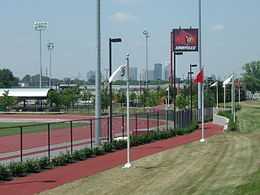
Acquired in 1923, the Belknap Campus is the school's main campus. It is located three miles (5 km) south of downtown Louisville in the Old Louisville neighborhood. It houses seven of the 12 academic colleges and features one of the casts of Auguste Rodin's The Thinker in front of the main administrative building, Grawemeyer Hall. The grounds of the campus were originally used as an orphanage, several of the original buildings used.[28]
The Belknap Campus has expanded greatly in recent years, with land housing abandoned factories in the area being purchased and redeveloped. Projects built since 1998 include Papa John's Cardinal Stadium and adjacent Trager Center fieldhouse, Owsley B. Frazier Cardinal Park (which includes Ulmer Stadium for softball, Trager Stadium for field hockey, Cardinal Track and Soccer Stadium, Bass-Rudd Tennis Center, locker rooms, a playground and a cushioned walking path), Jim Patterson Stadium for baseball, Ralph R. Wright Natatorium, Owsley Brown Frazier Sports medicine Center, and a lacrosse stadium. With new parking at Papa John's Cardinal Stadium, non-resident parking was moved there and the parking lots near campus were redeveloped with new dormitory buildings, including the Bettie Johnson Apartments, Kurz Hall, Minardi Hall, and "Community Park". Archived from the original on 2007-06-24..

Other points of interest on the Belknap Campus include the Rauch Planetarium, the Covi Gallery of the Hite Art Institute, and the final resting place for former U.S. Supreme Court Justice Louis D. Brandeis under the portico in the Brandeis Law School. Surrounded by, but not part of the campus, are the Speed Art Museum, a private institution that is affiliated with the University of Louisville, and the Confederate Civil War Monument, located at the juncture of 2nd and 3rd streets, which honors Confederate Civil War dead; this was built there before the school grew to surround the land it stands on, which is owned by Louisville Metro. The Kentucky State Data center, the state's official clearing house for census data and estimates, is located next to Bettie Johnson Hall.
Since 2008 the school has purchased three large tracts of land adjacent to the Belknap Campus, 55 acres (220,000 m2) to the school's northwest campus, 17 acres (69,000 m2) to the school's east campus - south of Hahn and 39 acres (160,000 m2) south of the Speed School of Engineering. New student housing has been completed on one of the northwest segments with student parking slated for the other. A new engineering and applied sciences research park is planned for the land south of the Speed School of Engineering. It serves as the centerpiece of a Signature Tax Increment Financing (TIF) district, designed to stimulate economic growth in an area around U of L’s Belknap campus. The TIF district covers more than 900 acres stretching from Belknap Campus south to the Watterson Expressway. The Kentucky Economic Development Finance Authority recently approved the TIF, paving the way for what could be an estimated $2.6 billion over 30 years. The historic TIF project will ultimately leverage the academic and research functions of the University of Louisville into an exceptional economic engine that will result in an influx of high-wage jobs, growing revenue for the region and state. The park will be designed to attract researchers and private businesses that have the opportunity to work directly and collaboratively with U of L, and ultimately create an economic hub that will transform the South and South Central areas of Louisville.
-

U of L Student Activities Center and Clock Tower
-

Belknap Campus from the Eastern Parkway overpass
-
.jpg)
Rauch Planetarium
-

Lutz Hall is home to the departments of Geography, Anthropology, and Engineering
Belknap Campus Development projects

In 2009, the university unveiled its new master plan for the next 20 years with efforts from U of L Foundation and other affiliate partners. Several important projects under construction or planned at that time included a new student recreation center, soccer stadium, new residence halls and academic buildings. Furthermore, the reconstruction of the I-65 ramps to the Belknap Campus, converting the four lanes of Eastern Parkway into a two-lane road with bike lanes and a landscaped median to improve pedestrian access to the Speed School, the moving of several university offices to allow the existing facilities at Arthur Street and Brandeis Avenue to be converted to commercial property and restaurants. The Yum! Center (a men's basketball and volleyball practice facility) was completed in the fall of 2007. A 12,000-square-foot (1,100 m2) Olympic sports training/rehab center adjacent to Trager Stadium is also under construction. Additionally, Trager Plaza, a small plaza with a fountain, statue, and garden has been built with donations by the Trager Family on the south part of campus. The $37.5 million Student Recreation Center, located on the Fourth Street corridor along the western border of campus, opened in October 2013. The Province, The Bellamy and Cardinal Towne are three new student housing developments built to the southwest of campus, near the recreation center. All three were built by private developers, and The Province was built in tandem with U of L's properties. In the short term, university provost Shirley Willihnganz expects the university to continue partnerships with private entities to build student housing.
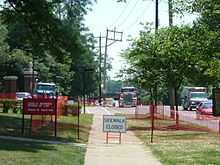
"We want an athletic program that is strong across the board. We want all of our sports to have an opportunity to be competitive and win championships. I believe strongly in having a complete athletic department, not just fielding teams that meet prescribed numbers" - U of L's Athletic Director, Tom Jurich.
-

Construction on Scholar's Hall on Lee Street, June 2008
-

Expansion of the Field Hockey stadium
-

Historic building on 7th Street being converted into a parking garage
Health Sciences Campus
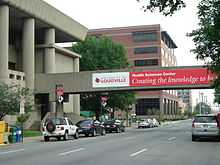
The U of L Health Sciences Center, also called the med campus, is located just east of Downtown Louisville in the Louisville medical park which contains two other major hospitals and several specialty hospitals, and it houses the remaining five colleges. This is the school's original campus, being continuously used since 1846, although none of the original buildings remain. Buildings of note on the HSC include the fourteen story Medical Research Tower and the ten-story University Hospital.Construction is finished for a recently opened, downtown Louisville Cardiovascular Research Innovation Institute building to be directed by a researcher, Stuart Williams from the University of Arizona; and an eight-story, $70 million biomedical research building. Faculty and students also work with neighboring hospitals including Kosair Children's Hospital, as well as outreach programs throughout Kentucky, including in Paducah, Campbellsville, and Glasgow.
-

Cardiovascular Innovation Institute
-

U of L Medical Research Tower
-

Baxter Research Building on the U of L Health Sciences Campus
-

University Hospital Medical Plaza, completed in June 2008
Health Sciences Campus Development projects
The U of L Health Sciences Campus has seen a large amount of new development in the past decade, include the completion of 3 new buildings (Baxter Research Complex, Cardiovascular Research Tower, and the Jackson Street Medical Plaza). Work is ongoing on the Biolab Research Tower, with a January 2009 completion date projected.
In 2007 U of L announced plans to create a nine-acre medical research park on the so-called Haymarket property roughly bounded by Market, Preston, Brook, and Jefferson Streets, along I-65 in Downtown Louisville, now called the Nucleus Research Park, with 1,000,000 square feet (93,000 m2) of research space. Nucleus, Kentucky’s Life Science and Innovation Center, was established in 2008 by the University of Louisville Foundation to integrate U of L resources with those of the region to transform Louisville into a major life science research hub. Nucleus is assisting in the development of U of L’s Health Science Campus downtown as well as improving the physical and economic health of Kentucky and the region.
Nucleus’ work is integral to the development of the research park currently underway at U of L’s Haymarket 30-block property in downtown Louisville. Nucleus Innovation Park will house multiple facilities in close proximity to expedite collaboration and shared expertise among researchers and companies creating a vibrant technology business district along the city’s healthcare/university/riverfront corridor. The project is expected to cost $300 million and would be constructed from 2009 to 2017. A 200,000-square-foot, eight-story, $18 million building, is the first in a series of structures, broke ground in July 2011, and is expected to open in June 2013.[29]
An important project adjacent to the Downtown Health Sciences Campus was the conversion of the Clarksdale Housing Complex into a new mixed income development called Liberty Green.
-

The eight story research tower is complete
-

Construction has just begun on the 10 story Bio Lab Tower
Shelby Campus
The 230-acre (0.93 km2) Shelby Campus is located on Shelbyville Road near Hurstbourne Parkway in Eastern Louisville. This campus was originally the home of Kentucky Southern College, a Southern Baptist liberal arts college that operated from 1961 to 1969.[30] After the college folded, it transferred all its assets and liabilities to U of L. It currently only has three buildings which are used for night classes and seminars, although construction of a $34.6-million Center for Predictive Medicine, a Level 3 biosafety facility is in the works.[31] The Shelby Campus is also home for the building which houses the Information Technology Resource Center (ITRC) for Homeland security. The ITRC conducts communications and IT research for the U.S. Department of Homeland Security as well as seminars and training in emergency preparedness and response. When completed, the impressive ShelbyHurst Office Campus will have over 1.5 million square feet of modern office space managed, developed and leased by NTS Development Co., in partnership with the U of L Foundation. The first three projects are in full swing.[32]
The U of L Shelby campus is undergoing a major renovation, with two new entrances to the campus off Hurstbourne Parkway. The overall goal is to develop 108 acres (0.44 km2) of the 230-acre (0.93 km2) campus for business, office, technology and research use, now known as the ShelbyHurst Research and Office Park. The university will spend $7.9 million on the road improvements on the campus. The roadway improvements began in August 2008, with work on a new four-lane boulevard through the campus, bordered by bike lanes, sidewalks, and will be heavily landscaped. The 600 North Hursbourne – Transformation is evident at the busy northeast corner of ShelbyHurst with the completion of 600 North. The LEED-certified, 125,000-square-foot office building is 80 percent leased and serves as corporate headquarters to Churchill Downs, NTS, Semonin Realtors and Stifel Nicolaus
500 and 700 North Hurstbourne Planning and design is currently underway for 500 and 700 North, ShelbyHurst’s newest properties. With construction set to begin later this year, these properties will have between 100,000 and 130,000 square feet of Louisville’s most prestigious office space. ShelbyHurst was designed around a four-lane boulevard through the campus bordered by bike lanes and wide attractive sidewalks. Special attention was given to enhancing green space and improving the life of the surrounding community. The green design of the entire development, combined with the convenience of a new boulevard and modern throughways, will facilitate driving, walking and biking through the campus.[33]
International Campus

The University of Louisville runs a sister campus[34] in Panama City, Panama, which has an MBA program.[35] The full-time program takes around 16 months to complete and enrolls about 200 students. It is currently ranked the 4th best MBA program in Latin America.[35]
The university also offers professional MBA programs in Athens, Hong Kong, Singapore and other parts of Asia. Their collaboration partner in Singapore is Aventis School of Management www.aventis.edu.sg
Other facilities
U of L operates the Moore Observatory in Oldham County, an astronomical observatory. There are also plans to purchase several hundred acres in Oldham County for the school's equine program.
Libraries
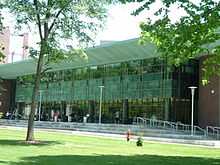
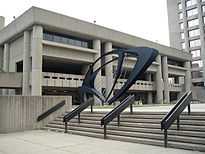
The University of Louisville library system is a member of the Association of Research Libraries, a fraternity of the nation's top college libraries.[36] U of L's main library branch is the William F. Ekstrom Library, which opened in 1981. The four-story building finished an expansion in March 2006, which increased its total size to 290,000 square feet (27,000 m2) and shelving capacity to over 1.3 million books. It is one of only five universities in the U.S. to have a robotic retrieval system,[37] which robotically places books in humidity-free bins.
There are five other libraries at the university, with a combined total of more than 400,000 volumes of work:
- Archives and Special Collections
- The Margaret M. Bridwell Art Library
- Dwight Anderson Memorial Music Library
- Kornhauser Health Sciences Library
- Brandeis Law School Library
The old Kersey Library Building will be converted to an academic building for the J. B. Speed School of Engineering. The Kersey Library collection was fully integrated into Ekstrom Library on January 15, 2007.
Enrollment statistics
Undergraduate student body
- Total enrollment is 22,293 as of Fall 2012.
- 76.2% of students are Kentucky residents.
- 44.0% of students are from Jefferson County (down from 64% in 1995)
- Average ACT Score: 25.0 as of Fall 2012 (up from 20.7 in 1995)
- 6-year graduation rate: 52.1% (2012) (up from 33% in 2004)


| Rank County | County | 2012 Enrollment [39] | 2010 Enrollment |
|---|---|---|---|
| 1 | Jefferson (Louisville) | 9,817 | 10,117 |
| 2 | Oldham (La Grange) | 840 | 802 |
| 3 | Hardin (Elizabethtown) | 629 | 682 |
| 4 | Bullitt (Shepherdsville) | 611 | 575 |
| 5 | Kenton (Covington) | 543 | 482 |
| 6 | Fayette (Lexington) | 449 | 484 |
| 7 | Boone (Florence | 369 | 352 |
| 8 | Daviess (Owensboro) | 292 | 273 |
| 9 | Shelby (Shelbyville) | 248 | 271 |
| 10 | Campbell (Newport) | 245 | no data |
Top five International countries for enrollment, Fall 2006
Top five US states (other than KY) for enrollment, Fall 2006
Note: *Panama enrollment includes U of L's Panama City campus,[34] which offers a full-time MBA program.[40] Note: **Beginning in 1998, as part of a reciprocity agreement with Indiana University Southeast in New Albany, Indiana, U of L began offering in-state tuition to residents of Clark, Floyd, Harrison, Washington, and Crawford counties in Indiana (residents of Metro Louisville wishing to attend IUS receive the same benefit) [41]
Residence Halls
The university has 12 University housing options:
Bettie Johnson Hall
401 West Cardinal Blvd. Louisville, KY (502) 854–2417
Billy Minardi Hall
2040 South 4th Street Louisville, KY (502) 854-9011
Community Park
2033 South 4th Street Louisville, KY (502) 854-9011
Herman & Heddy Kurz Hall
1900 South 4th Street Louisville, KY (502) 854-9011
The Province
600 Ruggles Place Louisville, KY 40208 (502) 636–1688
The Bellamy
1501 Bellamy Place Louisville, KY 40208 502.634.5996.
Cardinal Towne
Located on 1830 S 3rd Street is the University of Louisville's newest apartment style housing residences. Opening to over 400 students on August 15, 2011, the project has been a big success and has started expanding already. With assorted restaurants on the 1st floor such as Qdoba, HomeRun Burger, Comfy Cow, Jimmy John's, Cheesedongs, etc.
Louisville Hall
318 Brandeis Avenue Louisville, KY 40292
Miller Hall
A freshman only co-ed residence hall located near the Swain Student Activities Center. Mold was found in October 2012 forcing students to relocate.
Unitas Tower
Threlkeld Hall
A co-ed residence hall for honors students. Located right next to the Swain Student Activities Center.
Wellness House
Center Hall
Media
U of L's student maintained radio station, WLCV, began airing in 1968 and is broadcast on the internet and on a low level AM signal that reaches most of the Belknap Campus.[42] U of L holds a prominent role in the city of Louisville's "Public Radio Partnership" which features three NPR stations under one roof, including the school's namesake WUOL-FM which broadcasts classical music. The school also holds one-third of the seats on the Partnership's board of directors.
There is also an independent student-run weekly newspaper, The Louisville Cardinal. The newspaper was originally founded in 1926, and has maintained financial and editorial independence since 1980. The newspaper is overseen by a board of local media professionals and run by a student editor in chief.
Inside U of L's Student Activities Center is The Floyd Theatre, a 228 seat movie theater operated by the Student Activities Board. The theater is capable of running both 35 mm prints and DVD projection. The Floyd features a Thursday night film and another on Saturday & Sunday nights. Also, there is a recently instituted monthly Midnight Movie that runs on the last Friday of every month. The theater primarily shows independent and foreign films that get limited or no run in Louisville's many commercial theaters. Shows are open to all students, as well as the public.
Greek life
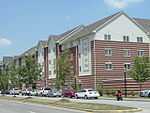
|
|
Notable U of L Alumni
Athletics

The Louisville Cardinals (commonly referred to as "the Cards") are the student athletes representing the university. There are 13 women's and 10 men's teams that participate in the American Athletic Conference. Louisville was invited to the Atlantic Coast Conference on November 28, 2012 and will begin play in 2014 in the ACC. The Cardinals are well known nationally in men's basketball with three national championships and 10 Final Four appearances, in addition to being the most profitable NCAA basketball program (with a net annual revenue of $18.5 million),[43] ranking 5th in NCAA Tournament wins, 9th in winning percentage, and 5th in annual attendance every year since 1984. The current head coach of the men's basketball team is Rick Pitino.
In recent years other Cardinal teams have gained national prominence. The women's basketball team, led by first team All American Angel McCoughtry, have been to two straight Sweet 16's and have been ranked in the top 10. In December 2008 the Lady Cardinals broke the Big East paid attendance record when 17,000 fans filled Freedom Hall to watch the Cards defeat rival Kentucky. Other U of L teams with recent post season success includes track and field (two individual national championships), volleyball (consecutive Sweet 16 appearances and a three-peat as Big East Tournament Champions from 2008–2010), and baseball (a College World Series appearance and consecutive Big East conference titles). All U of L locally broadcast games airing on the school's flagship affiliate WHAS-TV Louisville are televised on every cable provider in Kentucky.
Fight song
Notable among a number of songs commonly played and sung at various events such as commencement, convocation, and athletic games is the University of Louisville fight song, Fight! U of L!, written by Robert Griffith. Also notable is All Hail, a fight song written by current Athletic Pep Band director Al Greener.
See also
- The University of Louisville "RED RAGE!" Marching Band
- The University of Louisville Cardinal Singers
- The University of Louisville Collegiate Chorale
- History of Louisville, Kentucky
- McConnell Center
- American Student Dental Association
References
- ↑ 1.0 1.1 "Just the Facts 2012-2013". University of Louisville Institutional Research.
- ↑ "Color — University of Louisville". Louisville.edu. Retrieved April 16, 2013.
- ↑ "UofL Mission statement". Retrieved 2006-06-08.
- ↑ "UofL Fall '05 Enrollment by County". Archived from the original on 2007-12-01. Retrieved 2006-06-08.
- ↑ "UofL Fall '05 Enrollment by State". Archived from the original on 2007-12-01. Retrieved 2006-07-07.
- ↑ "Merck, Januvia and Blood Pressure Medicine: Merck Markets Cancer Vaccine Discovered by Louisville Doctors".
- ↑ "Robert L. Tools". Retrieved 2006-06-08.
- ↑ "America's First Successful Hand Transplant – One Year Later". 2000-01-31. Archived from the original on 2009-03-31. Retrieved 2009-03-31.
- ↑ "U of L Magazine — Summer 2000".
- ↑ "VSEL for More Information" (PDF). Archived from _for_More_Information.pdf the original on 2009-11-16. Retrieved 2006-06-08.
- ↑ "UofL History". Retrieved 2006-06-08.
- ↑ 12.0 12.1 "'Public Schools' entry from The Encyclopedia of Louisville ( c2001)". Retrieved 2009-03-02.
- ↑ "Alumni Association Scholarships". Louisville, Kentucky: University of Louisville. 2011. Retrieved September 25, 2011.
- ↑ "Going State". Retrieved 2006-06-08.
- ↑ "About REACH". Reach.louisville.edu. Retrieved 2009-08-05.
- ↑ "Layout 1" (PDF). Retrieved 2010-10-22.
- ↑ "America's Top Colleges". Forbes.com LLC™. Retrieved October 19, 2013.
- ↑ "Best Colleges". U.S. News & World Report LP. Retrieved October 19, 2013.
- ↑ "About the Rankings". Washington Monthly. Retrieved October 19, 2013.
- ↑ 20.0 20.1 "U.S. News Best College Rankings 2013". U.S. News & World Report.
- ↑ http://louisville.edu/institutionalresearch/institutional-research-planning/completed%20CDS%202011-12.pdf
- ↑ http://louisville.edu/institutionalresearch/institutional-research-planning/CDS2010_2011.pdf
- ↑ https://louisville.edu/institutionalresearch/files/common-data-set-files/CDS2009_2010%202.pdf
- ↑ https://louisville.edu/institutionalresearch/files/common-data-set-files/cds2008-09.pdf
- ↑ 25.0 25.1 25.2 25.3 25.4 "University of Louisville Common Data Set 2011-2012, Part C". University of Louisville.
- ↑ "Metropolitan College". Retrieved 2006-06-08.
- ↑ "UPS fuels economic gains". Courier. 2006-05-18. Retrieved 2006-06-08.
- ↑ "University of Louisville Buildings Once Housed Homeless Children". Archived from the original on 2006-09-04. Retrieved 2008-01-16.
- ↑ Green, Ed (2007-08-03). "Making hay: Haymarket project would represent nearly $300 million investment on East Jefferson". Business First of Louisville. Retrieved 2009-03-02.
- ↑ "UofL — Kentucky Southern College records". Special.library.louisville.edu. Retrieved 2010-10-22.
- ↑ "Bio Safety Lab".
- ↑ "theitrc.com". Retrieved 2009-08-05.
- ↑ "Shelby Campus infrastructure".
- ↑ 34.0 34.1 "Annual Study Abroad Program in Panama". U of L. Retrieved August 26, 2012.
- ↑ 35.0 35.1 "U of L Business School earns new rankings". 2005-10-24. Retrieved 2006-06-08.
- ↑ "Member Libraries". Retrieved 2009-03-02.
- ↑ "Robotic Retrieval System". Archived from the original on 2009-07-13. Retrieved 2006-06-08.
- ↑ "U of L Profile". Retrieved August 26, 2012.
- ↑ http://louisville.edu/institutionalresearch/institutional-research-planning/Just%20the%20Facts%202013%20Use%20this%20one.pdf
- ↑ "University of Louisville-Panama". Archived from the original on 2007-12-27. Retrieved 2009-03-02.
- ↑ "UofL Magazine: Journal". Retrieved 2009-03-02.
- ↑ Greenwell, Patrick (2008-03-18). "Frequency: After initial static, campus radio receives good reception". The Louisville Cardinal. Retrieved 2008-03-18.
- ↑ Farrey, Tom (2006-02-21). "NCAA might face damages in hundreds of millions". ESPN The Magazine. Retrieved 2009-03-02.
- Kleber, John "The Encyclopedia of Louisville" pp 902–903 History of the University of Louisville
- Mallalieu, William Cassell (January 1938). "Origins of the University of Louisville". Filson Club Historical Quarterly 12 (1). Retrieved 2011-11-29.
External links
| Wikimedia Commons has media related to University of Louisville. |
- University of Louisville official website
- University of Louisville official athletic website
- University of Louisville School of Medicine website
- The Louisville Cardinal Student Newspaper
- Info for Prospective Students
- Aerial View of Campus
- University of Louisville Images
- University of Louisville Yearbooks
- Images of University of Louisville in the University of Louisville Libraries Digital Collections
- Kornhauser Health Sciences Library History Collections
- Planned projects/ improvements to Athletic facilities
- UofL enrollment by county maps, also Top 10 counties by year & enrollment by KY regions
- The Patrick Henry Hughes story from ABC News
| ||||||||||||||||||||
| ||||||||||||||||
| ||||||||||||||
| ||||||||||||||
| ||||||||||||||||
 |
Old Louisville |  | ||
| South Louisville | |
St. Joseph | ||
| ||||
| | ||||
| South Louisville | Bradley |
 |
Ohio River |  | ||
| Downtown Louisville | |
Phoenix Hill | ||
| ||||
| | ||||
| Smoketown |
| ||||||||||||||||||||
Coordinates: 38°12′54.07″N 85°45′36.80″W / 38.2150194°N 85.7602222°W
